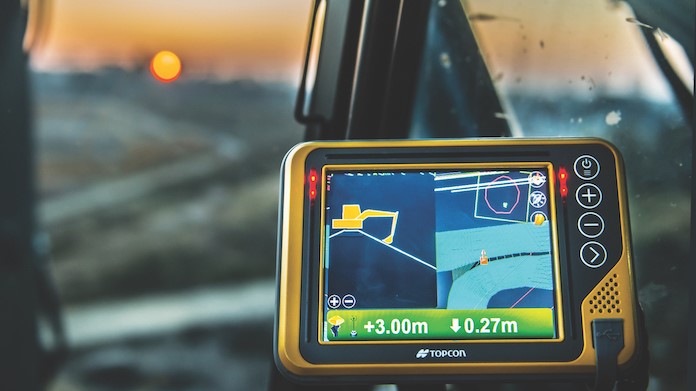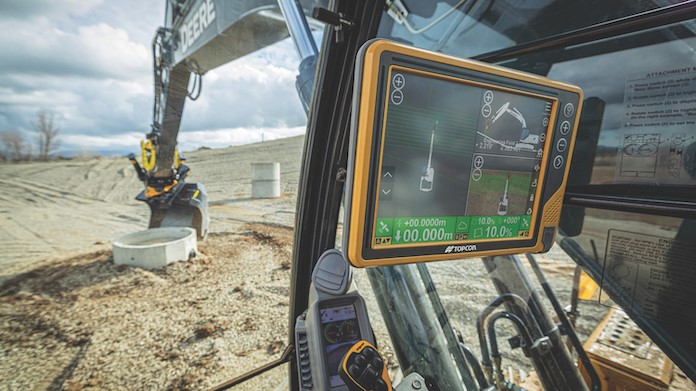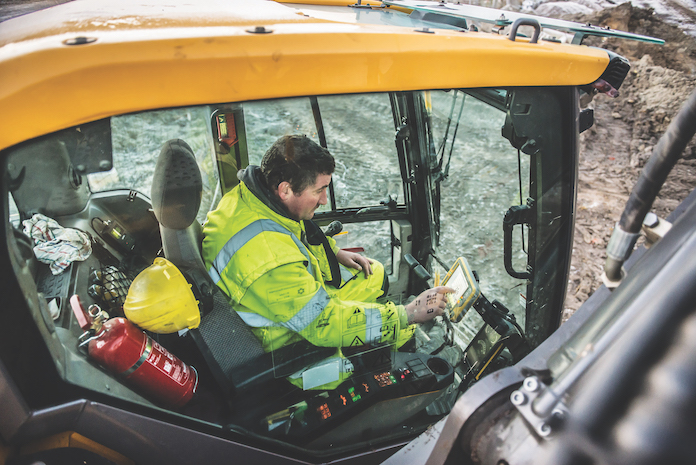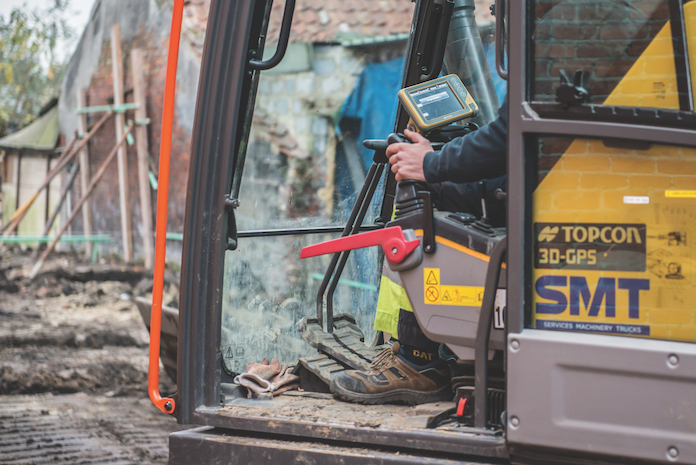
From diggers that can automatically grade to trucks that drive themselves, machine control technology is revolutionising the construction industry. Machine control and automated solutions should boost productivity and reduce costs – but how does this technology work, and what does the future hold? This CPD in partnership with Topcon Positioning GB explains
To understand how machine control is revolutionising the construction industry, we must first understand what is meant by the term ‘machine control’ and the reasons for its development.
Simply put, machine control hardware and software solutions were developed to determine a machine’s current position on the earth and compare it with a desired design surface. Using data from satellites or total stations and 3D models, the technology ensures that machine operators can accurately position machinery, check grade, automate equipment functions and collect data.
Through the use of various positioning sensors and a display, machine control gives operators a clear reference between the position of the machine bucket or blade and the design surface.

Used by the construction industry on earthworks equipment since the late 1990s, the technology allows decisions to be made based on data, rather than relying on fallible traditional methods or the skill and experience of the operator. As a result, machine control effectively increases operators’ productivity and accuracy.
Machine control solutions on dozers and graders, like Topcon’s 3D-MC², save operators time, money and fuel thanks to the technology’s improved accuracy and enhanced performance. Through the use of software like the 3D-MC² platform, operators have access to technology that brings all standard site positioning solutions and different machine types together, meaning they have the flexibility to mix total stations or GPS with both dozers and motor graders.

History of machine control
Machine control is gaining momentum across a variety of different types of construction equipment – including graders, dozers and more recently excavators. Prior to its adoption, however, operators had to manually check grade and position machinery themselves – a process that was less accurate, time consuming and held higher safety risks due to the grade checkers’ or banksman’s proximity to the machines.
Once 2D and 3D technology began to develop, so too did early machine control technology. Providing operators with access to simple visual guides, this early technology often used indicate systems to demonstrate how deep to cut and allowed dozer and grader blades to be controlled and kept on grade.
For this to work, rotating lasers were set up to transmit signals that could be picked up by sensors positioned on dozers or graders. This gave operators the basic information they needed for their grader or dozer. Yet, in comparison to modern-day machine control, these early systems were still very limited at providing a full and accurate picture and were also often too expensive or complex.
Present day challenges for the industry
Fast forward to the present day, and the construction industry is facing some significant challenges. It is no secret that there is a lack of fresh talent entering the sector. In particular, the sector has trouble attracting young people and, as a result, there are fewer operators entering the profession.
Should this trend continue, the industry will be left with a shortage of experienced and reliable operators, which means that the quality and productivity of projects will be impacted by a significant skills gap. To meet construction targets and tackle the skills gap head-on, the industry is turning towards automated machine control to enhance its workflow further.

Automated machine control
Going beyond simply providing operators with a visual guide to bucket or blade position, automated machine control moves the blade to grade by talking to the machine’s hydraulics.
Unlike with regular machine control, automated machine control technology places the responsibility for accuracy and speed firmly in the hands of performance enhancing technology. This means that through the use of this technology, new or less-skilled operators can perform like a professional and even the most experienced operators can work better and faster.
How well has automated machine control been adopted?
When looking at the current construction landscape, it is clear that, despite its significant benefits, machine control automation is not being adopted across all machines at an equal rate.
In fact, although automation is being embraced on machines like graders and dozers, the uptake has been much slower for excavators, with the adoption rate of automated machine control on these machines currently estimated at around 10% in Europe in comparison to a rate of over 50% for dozers.
In the past this was unsurprising, as, while the industry previously had a steady supply of skilled workers, the need for automation across excavators was not considered high. It is also harder to prove an increase in productivity on excavators, meaning that it was difficult to assess how great the need for automation was.
Nevertheless, it is clear that the industry now needs to reassess this requirement. With the demands for productivity increasing and a shortage of skilled operators, construction needs to embrace the benefits that investing in automated machine control can bring.

Topcon X-53x
There is now an opportunity for the industry to transform construction workflows by investing in automated excavation systems, taking the first step towards a fully automated site.
The Topcon X-53x Automatic Excavator, for example, uses the same components of the original machine control system with the addition of an ultra-smooth hydraulic interface. With easy-to-use finger-tip control, the technology is designed to provide automated depth control when digging to grade in flat, stepped or sloped applications. The system allows experienced operators to work better and faster, while new operators are able to perform like a professional.
By simply pulling back on the stick, operators can automatically control digging depth, boom elevation and the bucket angle – ensuring that they are on grade every time and avoiding over-digging. This saves both new and experienced operators time and money, through an estimated increase in productivity of around 30%. The technology also means that operators only move the earth that is required, which in turn avoids over-digging – saving additional costs of fuel and unnecessary transportation of materials.
Automated 3D machine control systems, such as Topcon’s X-53x Auto Excavator, also provide onsite safety benefits. By using the most advanced and precise GPS positioning technology and sensors, operators receive real-time, dynamic, on-screen bucket location and design views. Access to real-time designs means that operators can cut more accurately and check against complex designs in the cab, removing the need for someone to check the grade from the trench.
Thanks to onboard connectivity, automated machine control systems like these can also be used alongside software like Topcon’s Sitelink3D. This gives teams remote access to the excavators and reports can be generated from each machine and communicated to a central point.
Reports, data and even designs can be shared between the office and the in-cab display to ensure operators are being updated when changes are made in real time – reducing the need for reworks if plans change. Giving teams up-to-date information on performance also ensures that they can monitor onsite progress and make amends to designs in real time, even when working remotely.

The future of automated machine control
Automation is just the first step for machine control. Looking forward, not only will automation control machine angle and depth, but the whole excavation process looks likely to become automated – increasing productivity across the entire construction workflow.
Through the use of automated machine control technology, like Topcon’s X-53x Auto Excavator and digital management tools like Sitelink3D, machines will be able to act as sensors – monitoring the progress of projects and sharing accurate reports on productivity. For the wider construction workflow, these reports will then be used to synchronise with other functions within a project and associated equipment – such as trucks, to streamline the construction process and avoid delays to projects.
At present, deciding if more excavators are needed is a human-led decision based upon factors such as the length of the haul or the type of material excavated. In the future, fully automated construction workflows will allow project managers to accurately assess the rate of progress and resource the operation appropriately thanks to reports from the machines.
Construction professionals need to ensure they are upskilling their workforce through this technology and embracing the benefits it brings to a project, since fully automated construction workflows look set to be the answer to addressing infrastructure targets in the future.
This article has been created by Construction Manager in partnership with TopCon Positioning GB
Now answer the CPD questions (please note you must register or sign in first):
CPD Module Content
Information in this CPD was correct at the date of publication.


